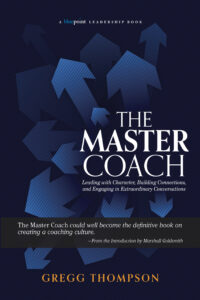(Note: in this article, Talent refers to the person being coached.)
Be A Great Coach
At the risk of sounding too idealistic, there are few things in life that are more rewarding or more meaningful than being instrumental in helping others have better lives. I often refer to coaching as a calling or mission because I believe there is something inside each of us that comes alive when we have an opportunity to be of real service to others. One of the key foundation stones upon which successful coaching is built is conversation – the dialogue you have with the people you are coaching.
But this conversation involves much more than just talking with others about their goals and dreams. As a coach, your job is to create a space in which other people will regularly have conversations that not only uncover new ideas and generate innovative solutions, but that result in entirely new attitudes and behaviors, and that forge commitments to make significant, sustained personal changes.
However, while rich dialogue can uncover new ideas and generate innovative solutions, this kind of interaction alone is not coaching. Where dialogue pursues new ideas, coaching pursues entirely new attitudes and behaviors. Dialogue is the talk; coaching is the walk. How many conversations do you have during an average day? How many of them really matter? The great coach understands why some conversations matter and some conversations do not. Most on-the-job conversations involve the exchange of information, instructions, advice, and opinions and have relatively predictable outcomes. While these conversations are quite suitable for normal business transactions, they are quite ineffectual in the coaching process.
Elements of a Great Coaching Conversation
Coaching conversations need to be much more potent. They are characterized by purposefulness, emotion, learning and direction. They are high-stakes interactions in which the coach and the Talent engage in a daringly candid conversation that can evoke a vast range of feelings. Coaching often requires the Talent to confront sensitive issues related to their personal performance and aspirations, and challenges deeply- held beliefs and ingrained practices. Over the course of one conversation, the Talent’s feelings may range from exhilaration to despair, confusion to clarity, and anger to tranquility. The coach needs to be able to remain in the conversation regardless of the emotions exhibited by the Talent. Sometimes performance coaching comes perilously close to therapy or counseling; however, it is important for the coach to recognize that the future is their province, not the past. This helps keep the conversation coach-like instead of therapy-like.
My friend and colleague Bob Johnson often describes a coaching conversation as a dance, but it is a dance in which the steps are not already rehearsed. The best coaching conversations have no predictable course and are, therefore, inherently uncertain and risky for both parties. They are often very simple and direct, but their outcomes are unknown. They take us outside our comfort zones and challenge us to consider new perspectives. The coaching conversation does not unfold without wrinkles; it confronts the questions that need to be asked and challenges the Talent to answer them honestly.
In business, we often take a very systematic, problem-solving approach to our work. Coaching requires that we set this attitude aside and instead embark on what may be a meandering conversation. Sometimes it will feel like it is going around in circles; other times it will seem to be going nowhere. Almost all coaching conversations find themselves in the pit of despair at some point. When this happens, the wise coach knows to trust the process and resist the temptation to turn back. Keep looking for the light, and sure enough, you will emerge with your pockets full of gold.
Authentic coaching conversations can only occur when we do not assume a particular outcome. They occur when we recognize that we do not have the answers for another but that we do hold the power to listen those answers out of him/her. If we let silence do some of the work, we enable the Talent to hear themselves say something that they might not know they already knew. Crucially, the conversation is a one-way street. By entering into it, the Talent has decided to explore personal changes, and the coaching relationship rests on them maintaining that commitment. If they go back on this commitment, the focus then must shift to examining what got in the way of them following through on what they committed to.
 A coaching conversation can happen during a dedicated coaching session, but such conversations don’t have to be confined to formal coaching sessions. Coaching can also happen “in the moment” during a spontaneous interaction in the hallway or at the coffee machine. A brief interaction in which you can share an insight, ask a big question, offer positive feedback, or engage in constructive confrontation is potentially as powerful as an hour-long scheduled conversation. What turns a chance interaction into a coaching conversation is first and foremost that it is Talent-focused. Master coaches also recognize that sometimes coaching occurs even in the absence of a specific conversation. They know that their examples can be a powerful catalyst for change, and so they strive to be coach-like in everything they do.
A coaching conversation can happen during a dedicated coaching session, but such conversations don’t have to be confined to formal coaching sessions. Coaching can also happen “in the moment” during a spontaneous interaction in the hallway or at the coffee machine. A brief interaction in which you can share an insight, ask a big question, offer positive feedback, or engage in constructive confrontation is potentially as powerful as an hour-long scheduled conversation. What turns a chance interaction into a coaching conversation is first and foremost that it is Talent-focused. Master coaches also recognize that sometimes coaching occurs even in the absence of a specific conversation. They know that their examples can be a powerful catalyst for change, and so they strive to be coach-like in everything they do.
Most leaders don’t have enough conversations with the people in their teams or their companies, and especially not conversations that are focused solely on those people. Leaders need to value conversation more, recognizing it as the lifeblood of their organizations. Conversations are to organizations as blood is to the body. If it stops flowing, the body dies. Wise coaches take every opportunity to have a coach-like conversation, whether it happens in an office, at the coffee station, in a hallway, or at the bar after work. They know that doing so keeps their organizations alive and well.
Adapted from THE MASTER COACH: Leading with Character, Building Connections, and Engaging in Extraordinary Conversations by Gregg Thompson. Copyright (c) 2017 by Gregg Thompson. All rights reserved.

